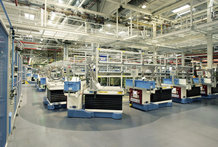The success story of invisible technology
IPT® - Inductive Power Transfer
Silent technology anniversary: 10 years of inductive power and data transfer / Global demand for innovative IPT® applications in conveyor technology is increasing / Ferrari contracts Wampfler AG for electrification of skillet lines
Weil am Rhein, Germany, August 2007 marks the silent anniversary of innovative, almost invisible technology: contact less power and data transfer systems have set new standards in conveyor technology worldwide. In addition to many other renowned companies such as Airbus, BMW, Eurocopter and General Motors, Ferrari now also utilises the inductive solution for the production of its 8 and 12 cylinder sports cars. Wampfler AG will equip the production facility in Maranello, Italy, with two skillet lines featuring the contactless power transfer system IPT® (Inductive Power Transfer). The 57 skillets have a conveyor length of 550 metres.
The company with its main office in Weil am Rhein, Germany, is one of the global leaders in the production of power and data transfer systems which transfer to mobile consumers such as conveyor systems, cranes and amusement parks. The specialists from Baden played a key role in the development of IPT® and can now look back on 10 years of success. In the meantime, more than 400 plants worldwide demonstrate innovative technical solutions, increasing productivity in the automotive and logistics industries.
The principle of contactless transfer
IPT® is used for running floor systems, electrified monorail systems as well as skillet lines, among other systems. "'Inductive technology' means contactless transfer of power and data to mobile consumers such as transport vehicles," Matthias Wechlin, IPT® product manager at Wampfler AG, explains. The system makes mechanical and galvanic contacts in power and data transfer unnecessary. Conveyor systems are thus not susceptible to environmental influences. Mechanical abrasion, one of the main reasons for maintenance work, is almost non-existent and running costs can be decreased. Application in severe circumstances, e.g. soiling caused by water or oil, is made possible. Furthermore, floor space for transport is not wasted because the cables are invisibly installed under the floor.
Successful work in development
The industrial success story of the inductive solution began at the start of the millennium, when ground conveyor belts were first applied in a "marriage line" where the chassis and body were joined in a time-critical assembly section. Today, the application is state-of-the-art technology for conveyor belts without their own energy storage in many automobile factories worldwide. In 1996, Wampfler AG started developing power and data transfer systems based on patents by the University of Auckland. The specialists were able to advance the systems continually and realise many major projects worldwide such as the installation of the first inductive plant in the industry at BMW in the year 2000. "We are proud of the fact that our IPT® technology has proven its efficiency and reliability for approximately ten years now. We offer complete solutions, including power and data transfer, vehicle guidance and positioning," Wechlin reports.
How IPT® works
The inductive solutions by Wampfler combine a primary and secondary device. They are linked electromagnetically, in the same way as in a transformer. However, the transfer takes place via an air gap, without mechanical or galvanic contacts. The primary device consists of track supplies which produce an output voltage of 20 kHz from a mains voltage with a frequency of 50 or 60 Hz. A track cable is placed along the transfer path. A magnetic field forms around the track cable, which oscillates at 20 kHz. The field frequency enables the transfer of power via air gaps.
Wide field of application
In ground transport systems, the use of IPT® makes mechanical protection for the supports of the power and data transfer system unnecessary, thus allowing the complete floor space to be used for transport. "Isolated conductor rails are an efficient solution by Wampfler for skillet lines, such as those currently being realised at Ferrari. The crucial factor is that the existing conditions are observed and the transfer system is installed correctly," Wechlin comments. In this case, an inductive solution has a primary advantage: Varying voltage capacities are irrelevant - such protective circuits are not necessary. Mechanical threading is simplified considerably by inductive solutions. Furthermore, IPT® is used in many other applications – the success story of this innovative technology will continue worldwide.






